Yoginis are a class of divine and semi-divine deities who emerged in the 5th century AD and remained in worship till 13th century AD, after which their cult seems to have become extinct. Originally esoteric deities, by the 10th century Yoginis became prominent in the wider religious landscape, as attested by their entry into Puranic literature and the unique circular, open-air temples enshrining them across the subcontinent (Dehejia 1986:10).
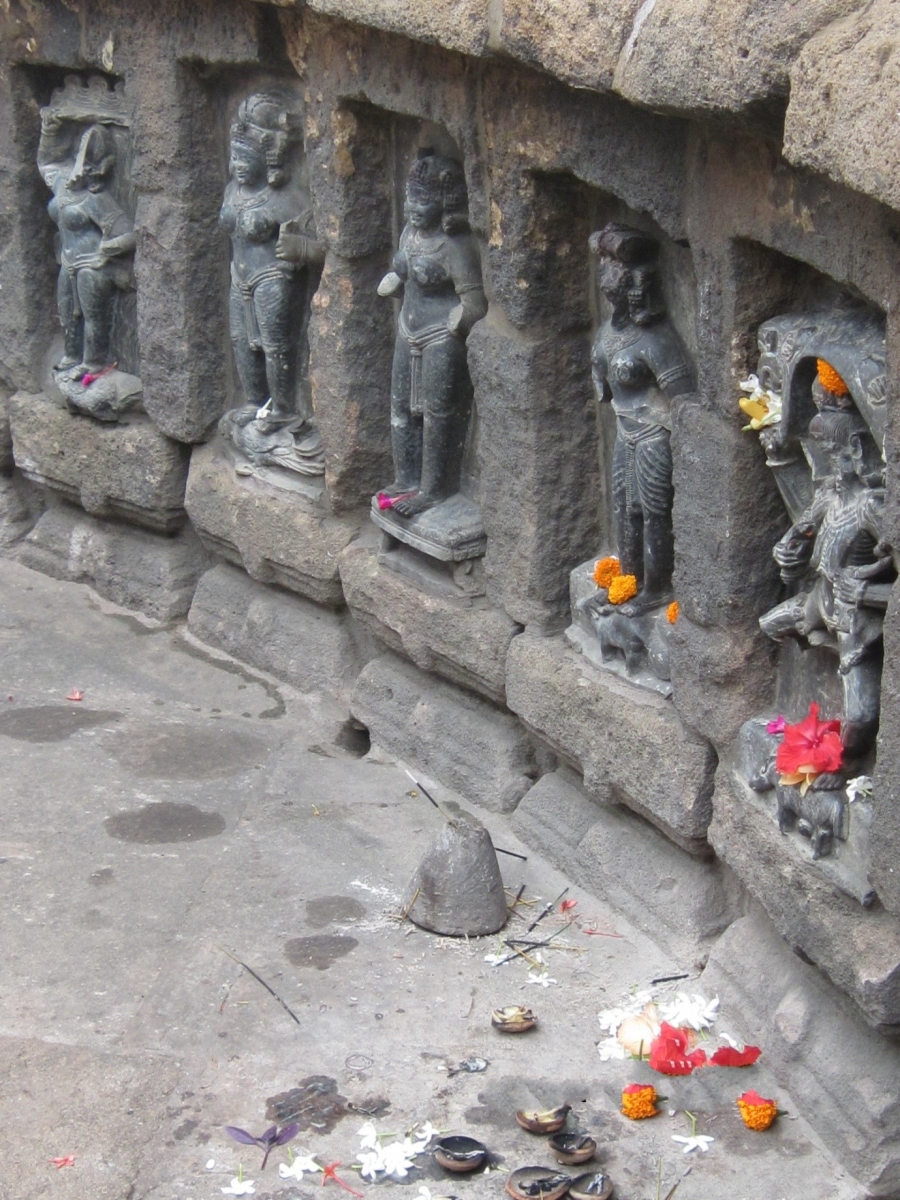
Yoginis, Chausaṭhi Yogini temple, Hirapur
The Chausaṭh Yogini cult, though comprising of Yoginis, is slightly different as the term ‘Yogini’ can represent diverse religious and cultic entities ranging from a yogic adept, a partner in Chakra-puja, a sorceress, astrological deities, Yoginis of the internal chakras, Yoginis of the Sri Chakra, a Devi or the Great Goddess, aspects of Devi, attendants of the Devi, acolytes of the Great Goddess or the Matrkas, Kaula Mata or patron goddess of the Kaulas, and variants of Yakṣiṇis and Dakinis (Roy 2015:224). The Chausaṭh Yoginis are however a group of goddesses who belong to a class of Vidyapiṭha deities, [i] who draw their allegiance to Matrkas and Bhairava. The symptomatic characteristics that define the Yogini cult include tightly-bound clans or groups, association with magic and occult, martial prowess, sexuality (both anti-sexual and hyper sexual) and death.
The Hirapur Yoginis are devoid of any inscriptional details, having been identified based on their iconographical features by the Odia scholar Sarala Das’s 16th century text Chandi Purana. Though the text is of a much later origin than the temple itself, it appears that Sarala Das included these Yoginis in his text as it might have been a thriving temple in his times, and also because some of these Yoginis have individual temples to themselves spread across the length and breadth of Odisha. The Yoginis of Hirapur are widely represented; these Yoginis like most of the other Yogini sets follow a similar tradition of including other female group divinities like Sapta Maātrkās within the Yogini group. They also include the deities of the Asta-Dikpalas. What is unique about the Yoginis of Hirapur is the sheer range that is seen in terms of mounts, attributes and even hairstyles. In Hirapur, there are lesser number of composite figures (comprising an animal head and a human body) than Ranipur Jharial.
All the Yoginis depicted here are in standing position and are much less elaborate than the Yoginis belonging to later period, the ones found in Chausath Yogini temples of Madhya Pradesh and Uttar Pradesh. Barring one, each of these Yoginis have a variety of mounts, especially animals. Unlike the sombre and meditative Yoginis of Bhedaghat or Rikhiyan, Hirapur Yoginis range from deities in celebratory to warfare mode. Some of these Yoginis have Kapalika or crematoria iconography where they are depicted standing on a corpse or carrying and even drinking from a skull cup. These very expressive Yoginis are seen merrymaking while drinking from a wine vessel, playfully touching their toes. The ones which are in war mode are Agneyi, Chamunda, Bhalluka, Aghora and Vindyavalini. The theomorphic figures include Narsimhi, Ostagriva, Varahi, Sarpassa, Ganesi, Bhalluka and Vikatanaina.
Appropriation of the Matrkas and the Maa
The Yoginis are closely associated with the Matrka cult as is evident from the close connection between the early depictions of mother goddesses and emergent conceptions of Yoginis. Early tantric treatises on Yoginilakśaṇa or 'the characteristics of Yoginis' classify these goddesses according to clans (kula, gotra) that have the seven or eight mothers as matriarchs. The clan mothers are those in whose nature the Yoginis partake as amsas, ‘portions’ or ‘partial manifestations’ (Shaman 2012:108). It is possible that the numeric grouping of seven or eight that is found in the Matrka tradition also got replicated in the Yogini cult and with that the number Chausath or 64 came to be associated with the Yoginis.
One of the major sources which link Matrkas to Yoginis is the Mahabharata. Though Mahabharata does not necessarily attest the presence of any temples dedicated to the seven mothers, Salyaparvan lists the name of the seven mothers who have features similar to the later age Yoginis. Among these mothers, some are said to have claws, fangs and beaks. This corresponds to some the Yoginis which have demonic features and composite bodies.[ii] Some of them are youthful maidens, while others are fleshless or potbellied. These Yoginis are said to dwell in ghoulish spaces such as cremation grounds. The theriomorphism, shape-shifting, multiplicity, extraordinarily variegated appearances, bellicosity, independence, simultaneous beauty and danger of the Yoginis all find precedent in these early mother goddesses, as does their connection with khechari vidya or the power of flight. They also come to play a protective role vis-à-vis the world in later mythology, although some of their early inauspicious and wild characteristics tend to persist in these accounts.
The Hirapur Yoginis in their visual form are feminised powers of sustenance, fecundity, contagion and mortality. In Odisha, the cult of the Yoginis developed in a parallel manner alongside the Matrka cult, and more often than not their paths seems to have crossed. The entire Sapta Matrka group, including Varahi, Aindri, Kaumari, Vaishnavi, Chamunda, Maheshwari and Brahmani, is found in Hirapur. Apart from the Matrkas, other important cultic mothers worshipped throughout Odisha can also be seen as Yoginis in Hirapur; one such example being Viraja. Viraja in her present cult image in Jajpur is worshipped as a two-armed Mahisasuramardini; however, in Hirapur she becomes a very indistinct and placid looking Yogini. The said Yogini is twin-armed and is shown standing on top of an unidentifiable spherical object out of which a lotus stalk appears to be rising. She has nothing in common with either the goddess called Viraja or Durga. Both her hands are missing and the only attribute that is common to Viraja and this Yogini is the lotus. There could be two factors leading to this kind of simplistic and almost insipid depiction. Firstly, since the central deity of the shrine (worshipped as Mahamaya) who is depicted quite majestically is a tantric divinity, it seems unlikely that a brahmanical icon could have warranted a similar treatment in terms of depiction. Secondly, it is possible that the Yogini was represented keeping in mind her tribal/folk antecedents as Stambhesvari, and therefore it is devoid of any special characteristics. It is possible that this particular Yogini could be just a form of Viraja without exactly replicating each and every iconographic details of Viraja or Durga. Her diminished status in a distinctly tantric sanctum might have led to the reinterpretation of her iconography.
This goes on to show that the appropriation that took place was not only from the tantric to the brahmanical, but also the other way round. The Yogini ascribed as Viraja, is also an evidence of one such assimilation.
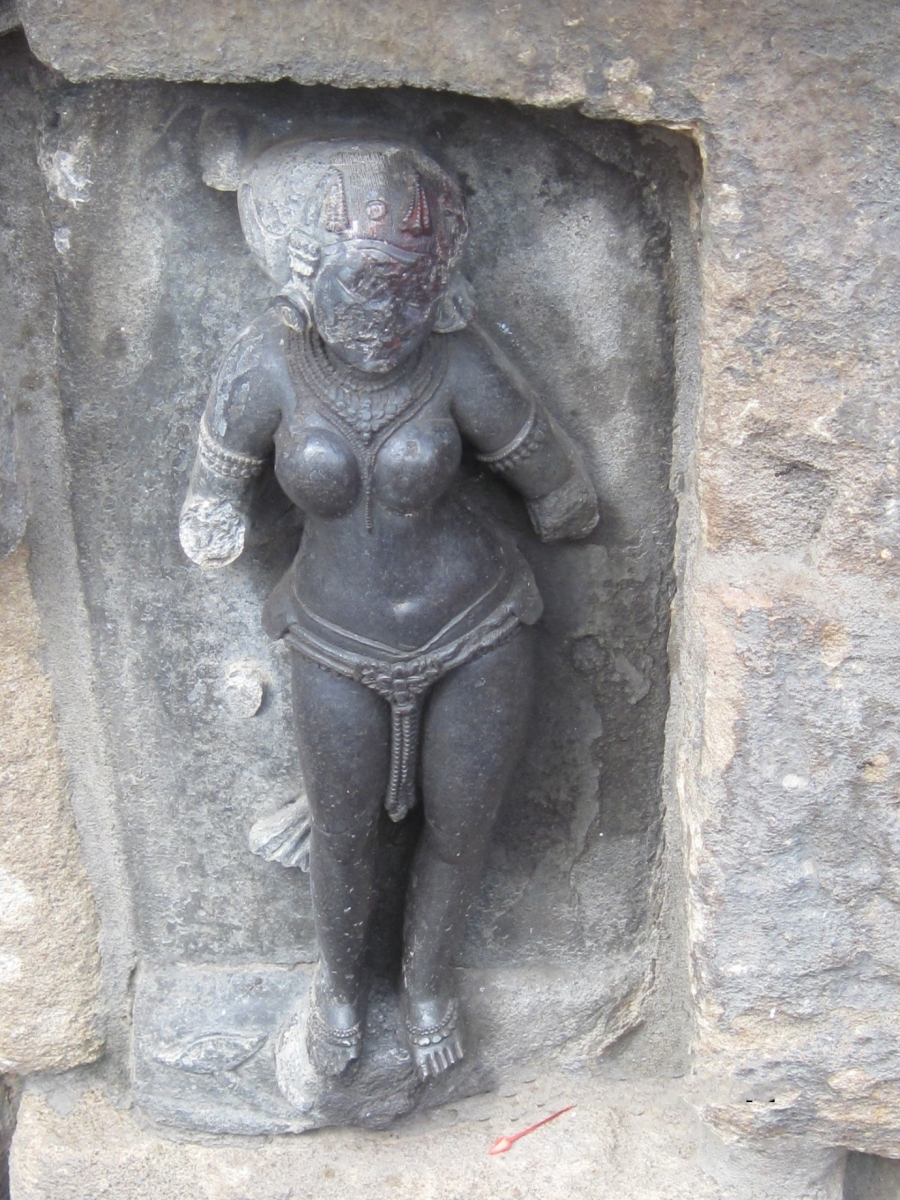
Yogini Viraja Chausathi Yogini Temple, Hirapur
(Un)Sacred sexuality and (De)Sexualized icons
Tantrism embodies a critical and controversial attitude toward women, sexuality and their relationship with their bodies, social classes and traditional notions of purity and impurity. The Yogini lexicon comprises of a gendered entity who can be an ogress, a sorceress, healer, female attendant to the present day woman who can be called a Yogini if she is healing people by getting possessed. According to Anamika Roy (2015:224), when it comes to Chausaṭh Yoginis, ‘the question of a goddess ensconced in a patriarchal framework does not arise here. Male worshipping the goddess may not present a symbol of the powerful position of women in society. Goddess worship had always been there in society. There was no inherent advocacy that a powerful symbol like goddess be translated into the question of gender.’ In Hirapur, one comes across a fascinating group of Yoginis who in their original mythological context had been confined to the roles of consorts, attendant deities and possessed women; however, with their entry into the Yogini cult they are transformed into individual ferocious deities, for instance the Yogini Sarasvati who has the body of a female, carries a veena, but is moustachioed as she can be seen twirling her moustache with one of her hands. This Yogini is an androgynous representation of the goddess of learning representing a process of synchronisation of the masculine and feminine aspect within a Yogini, which was not replicated elsewhere among other Yogini temples or sculptures.
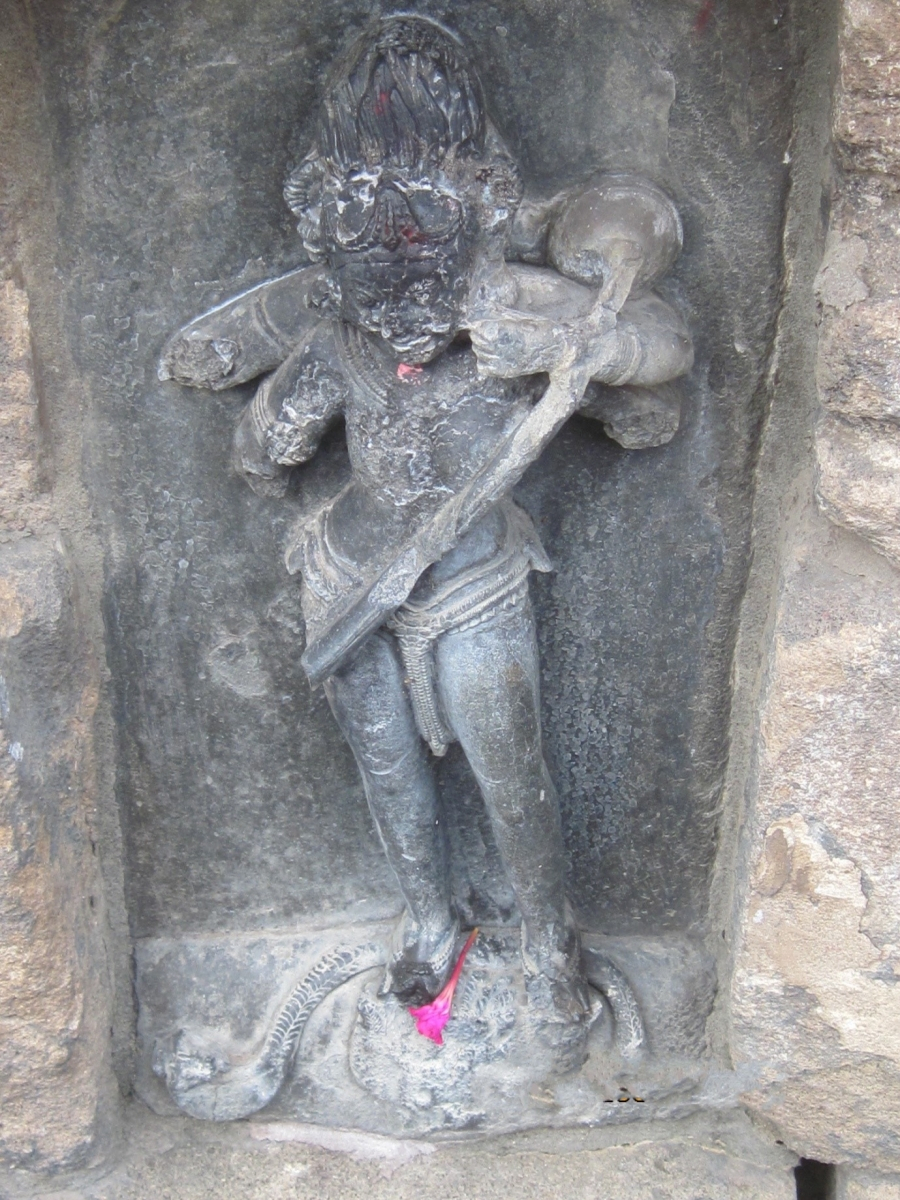
Yogini Sarasvati, Chausathi Yogini Temple, Hirapur
Sarasvati as the androgyne in Hirapur Yogini temple is not clearly split into half but is delicately fused. There is no clear cut left or right distinction as is found among other deities like Siva-Parvati, Visnu-Laksmi, Hari-Hara. Similarly, another Yogini in the Hirapur temple identified as Rati holds no resemblance to the beauteous Rati who is also the consort of Kamadeva. This particular Yogini has a grotesque face and is almost macabre in appearance. Interestingly, this Yogini has Kamadeva as her mount. Her face is feral to the point of being feline, which also raises the possibility of her being a prototype of Narsimhi. Though there already exists a Narsimhi-like Yogini at Hirapur, but the possibility of this Yogini belonging to that group cannot be completely ruled out. If this is so, she becomes the third feline Yogini at Hirapur, the other two being Narsimhi and Ostrarudha.
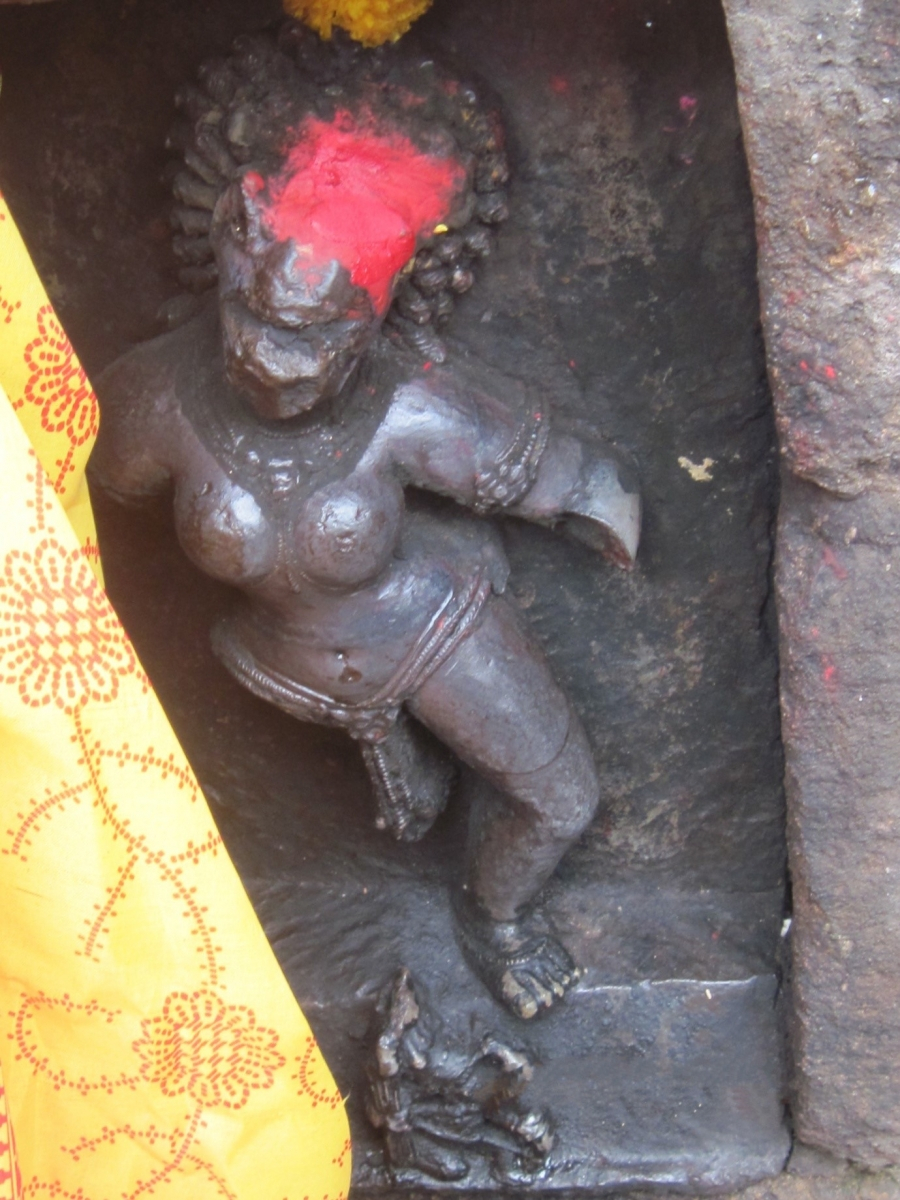
Yogini Rati, Chausathi Yogini Temple, Hirapur
The Yogini is twin-armed but her hands are broken therefore it is difficult to find out about her ayuddhas (attributes). This particular representation is both unusual and complex because of two factors: a) Yoginis are basically devoid of any male counterparts, but here is a Yogini who not only is a famed mythological wife but is also represented in the temple with her spouse. b) The Yogini in question is seen doing the exact opposite of what Rati represents: not only is she standing on top of her husband, but she is also seen to be trampling him.
There is a possibility that this Yogini with her macabre monstrosity is seen to be trampling the egoistic Kamadeva. Figuratively, she is very close to the ogresses who accompany Bhairava to charnel grounds as is described in the texts, but what can be seen here is the unbridled and intemperate passion of a woman who is otherwise a famous consort/wife. Rati or the Yogini here transcends the conventional spousal role, and instead takes on a more dynamic and ferocious role of an ugra devata (fierce deity) who dismantles the gender roles.
The Unsocial Paragons within the Tantric order
Why would one wish to identify with, to actually become (in the logic of Tantra), a goddess, each of whom dramatically embodies marginal, polluting or socially subversive qualities? These goddesses are frightening, dangerous and loathsome. They often threaten social order. In their strong associations with death, violence, pollution and despised marginal social roles, they call into question such normative social ‘goods’ as worldly comfort, security, respect, and honour. One of the most important iconographic representations that has been found among the Yoginis is that of Kapalika which is recurring in nature. The Yoginis are intrinsically connected to Bhairava who, in most of the extant Chausath Yogini temples, is depicted as the leader of the Yogini group. Some of the Yoginis frequently bear skulls and bone ornaments, skull cups and skull staves (khatvanga), as well as incorporate other elements of radical tantric iconography. This category of Yoginis comprise of the belligerent and the violent ones who are revered and feared because of their unpredictably antinomian nature. These quintessential vamayoginis are differently classified as raktapayini, surapayini, garbhabhaksa, maṁsapriya and many other such titles that evoke fear and mystery.
Every Chausath Yogini group comprises of some of the more identifiable and well-known goddesses but there are some who are relatively obscure and unknown. These could include folk deities, village goddesses and tribal goddesses. These lesser-known goddesses could be in worship in the region due to their association with disease, sudden death, and other realities that threaten the stability and even the existence of the village system. They might be understood as instigating society's confrontation with the chaotic, demonic, disruptive dimensions of life, particularly in the context of festivals when the village goddesses are fully invoked. They, like the diseases so often associated with them, are unpredictable in their moods. They erupt onto the scene suddenly, always powerfully and undeniably, and usually dangerously.
It is interesting to note that in Hirapur, not every Yogini with antinomian qualities is represented in a repulsive or a wrathful way. We find examples like Charcika, Chandika, Tara and others, otherwise known for their martial and destructive traits, are depicted in a sober and pacific manner. Similarly, a Yogini allegedly identified as Yamuna is far removed from the conventional and very graceful riverine goddess. Hirapur has come to represent juxtapositions which can at best be said to have order within chaos and chaos within order. It is worth reiterating that none of the Yoginis have been identified, and this case study is an attempt to suggest iconographic factors that could help in doing so even if hypothetically.
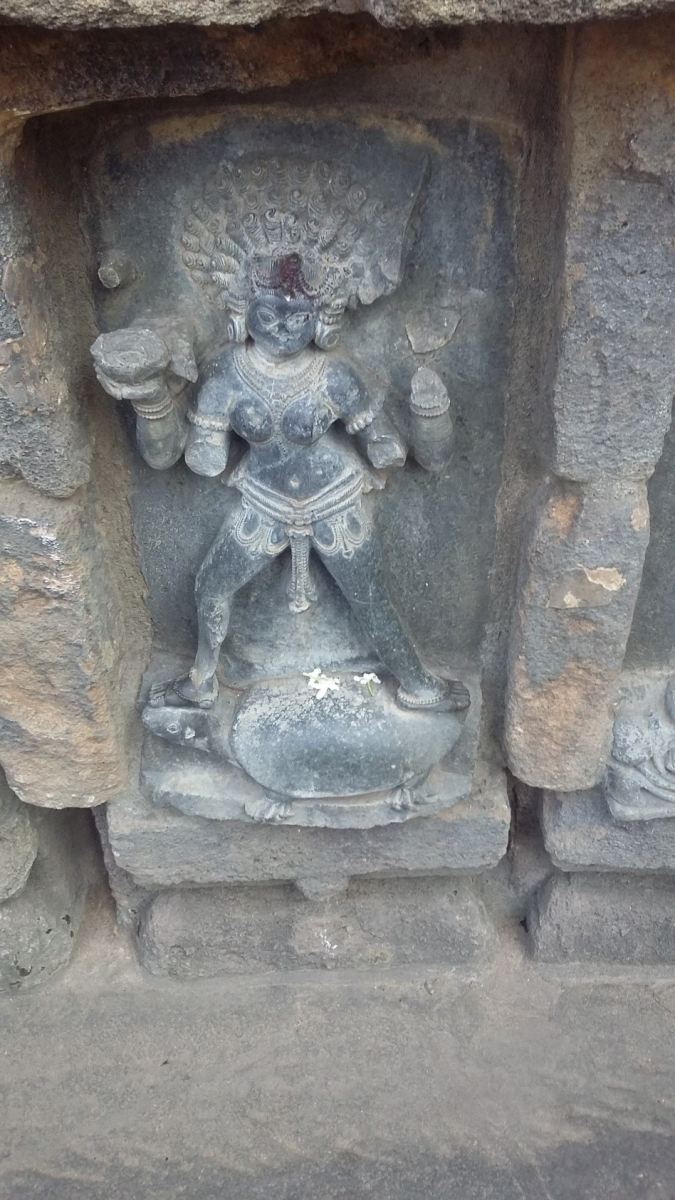
Yogini Yamuna, Chausathi Yogini Temple, Hirapur
The fierce and animal faces of the Yoginis is a way to show that these beautiful Yoginis could transform themselves with ease. While the exterior signifies that the Yoginis have the power to destroy evil and anti-life forces, the attribution of extraordinary powers also serves the purpose of taking the Yoginis out of the realm of human existence. With such powers, they transcend the human sphere to become deities.
Conclusion
One recurring factor that came into perspective is the constant strife between the authentic self and the other, in a way that the exterior or the visual is the other, and it is hiding the self. The Yoginis of Hirapur display a constant antithetical visual representation to their textual self. As Yoginis, they are found to be hiding their true identity under layers of ascribed meanings and symbolism.
It is worth exploring the interpolations and cross-cultural exchanges that took place across the board when it came to Yoginis, who migrated from different religions, tribal and folk societies and even from other goddess cults, like the Mahavidya group of goddesses who were a much later phenomena, but we find their Yogini prototypes in Hirapur. The Chausath Yoginis also challenge the preconceived gender and sexual roles with the kind of impunity that is replicated only to a limited extent by the Mahavidyas.
Yoginis of Hirapur
Table: Iconographic elements and attributes of the Yoginis at Chausathi Yogini Temple, Hirapur
|
Name |
Seat/Mount |
Arms |
Attributes |
|
Standing on a corpse |
4 |
Broken |
|
Dancing on a corpse |
2 |
Broken |
|
Wine vessel |
2 |
Kalasa |
|
Elephant |
2 |
Skull cup |
|
Bull |
2 |
|
|
Tortoise |
4 |
3 arms broken, one holding a skull cup |
|
Lotus |
2 |
- |
|
Alligator |
4 |
Broken |
|
Elephant |
2 |
Broken |
|
Buffalo |
4 |
2 arms broken, other two holding skull cup and bow |
|
Sea waves |
2 |
Broken |
|
Snake hood |
2 |
Khadaga and garland |
|
Camel |
4 |
Broken |
|
Owl on pedestal |
2 |
Broken |
|
Boar |
2 |
Broken |
|
Damru (stringed drum) |
2 |
Broken |
|
Human figure |
2 |
Broken |
|
Fish |
4 |
Broken |
|
Human head |
4 |
3 arms broken, one holding a bow |
|
Hill |
2 |
Broken |
|
Frog |
2 |
Broken |
|
Lion |
2 |
Both the hands lifting an elephant skin |
|
Dog |
2 |
Both the hands holding right leg |
|
Snake |
4 |
3 arms broken, perhaps holding a Veena |
|
Pedestal |
2 |
Broken |
|
Series of waves – water |
2 |
- |
|
Series of Kalasas |
2 |
Broken |
|
Flower creeper |
2 |
1 arm broken, other holding damru |
|
Flowers |
4 |
2 of the upper arms broken, lower hands holding a pot |
|
Lotus bud |
2 |
- |
|
- |
2 |
Broken |
|
Lotus |
2 |
Long garland and vajra |
|
Peacock |
2 |
Broken |
|
Lotus |
10 |
- |
|
An archer holding a bow and arrow, probably Kamadeva |
2 |
Broken |
|
Crab |
2 |
Broken |
|
- |
4 |
Broken |
|
Buffalo |
2 |
Broken |
|
Crow |
2 |
1 arm broken, other one holding a bell |
|
Ass |
2 |
- |
|
Scorpion |
4 |
Bow |
|
Mongoose |
4 |
1 arm broken, two hands leaning down to touch knees and one holding a damru |
|
Cock |
2 |
Broken |
|
Lion |
2 |
Broken |
|
Pot |
4 |
Broken |
|
Human body |
2 |
One arm broken, other holding Trisula |
|
Flower |
4 |
2 arms broken, other two holding nagapasa and in abhayamudra |
|
Conch shell |
2 |
Broken |
|
- |
4 |
Broken |
|
Wooden cot |
2 |
Broken |
|
Ram |
2 |
1 arm broken, other holding a sword |
|
Parrot |
2 |
Broken |
|
Stool / Pedestal |
2 |
Broken |
|
Cow |
2 |
Broken |
|
Musk Deer (Dora) |
4 |
2 upper arms holding a lion; sword, severed head |
|
Deer |
2 |
Broken |
|
Crocodile |
4 |
2 arms broken, other two holding lotus and nagapasa |
|
Duck |
2 |
Winnowing fan |
|
Horse |
2 |
Broken |
|
- |
- |
- |
|
Doe |
4 |
Broken |
|
Horse |
4 |
Shield, bow; lower 2 hands broken |
|
Deer |
2 |
One hand resting on a breast |
|
Rat |
2 |
Broken, but appears like holding a bow and arrow |
Bhairavas
The Bhairavas of the central shrine are seated in lalitasana except Ekapada Bhairava who is standing on one foot. All the Bhairavas are depicted with erect phalluses or urdhava linga. Like the Yoginis, the Bhairavas too appear calm and smiling and not in the ferocious avatar.
Table: Iconographic features of the Bhairavas of Hirapur Yogini Temple
|
Name |
Arms |
Mount |
Attributes |
|
Ajaikapada Bhairava |
4 |
Seated on a lotus |
Khadaga , shield; other two arms broken |
|
Svachchanda Bhairava |
10 |
Seated on two lotuses |
Dead body, aksyamala, skull cup and damaru; other arms broken |
|
Canda Bhairava |
10 |
Seated on a lotus and female figure |
Damaru, flute, aksyamala, trisula, shield; other arms broken |
|
Canda Bhairava |
10 |
Seated on a lotus and female figure |
Damaru, flute, aksyamala, trisula, shield; other arms broken |
Katyayani
The Katyayanis unlike the Yoginis are carved in sandstone. Out of the nine Katyayanis, seven are shown flanked by an attendant holding an umbrella. These Katyayanis are gaunt warrior figures each holding a weapon. All the Katyayanis are standing on a human head (each looking different from the other) and are flanked by a dog.
Table: Attributes of Katyayanis in Hirapur Yogini Temple
|
Katyayani |
Attributes |
Mount |
Attendant |
|
1 |
Sword |
Severed human head |
- |
|
2 |
Skull cup |
Severed human head |
Present |
|
3 |
Knife, skull cup |
Severed human head |
Present |
|
4 |
Aksyamala |
Severed human head |
Present |
|
5 |
Skull cup |
Severed human head |
Present |
|
6 |
Aksyamala |
Severed human head |
Present |
|
7 |
Knife, skull cup |
Severed human head |
Present |
|
8 |
Knife, skull cup |
Severed human head |
Present |
|
9 |
Sword, Danda (staff) |
Severed human head |
- |
References
Dehejia, V. 1986. Yogini Cult and Temples: A Tantric Tradition. New Delhi: National Museum.
Hatley, Shaman. 2012. ‘From Mātṛ to Yoginī: Continuity and Transformation in the South Asian Cults of the Mother Goddesses’, in Transformations and Transfer of Tantra in Asia and Beyond, ed. István Keul, pp. 99-129. Berlin: Walter de Gruyter.
Roy, Anamika. 2015. Sixty-Four Yoginis: Cult, Icons and Goddesses. New Delhi: Primus Books.
Further Readings
Donaldson, Thomas E. Hindu Temple Art of Orissa 3 vols. Leiden: Brill, 1985.
———. Tantra and Sakta Art of Orissa vol. II. New Delhi: D. K. Printworld, 2002.
Flood, G. Tantric Body: The Secret Tradition of Hindu Religion. London: I. B. Tauris, 2006.
Gadon, Elinor. ‘Probing the Mysteries of the Hirapur Yoginis’. In ReVision Vol. 25, no. 1 (2002): 33-41.
Hatley, S. The Brahmayamalatantra and Early Saiva Cult of Yoginis. Unpublished PhD dissertation, University of Pennsylvania, 2007.
Mahapatra, K. N. ‘A Note on the Hypaethral Temple of Sixty-four Yoginis at Hirapur’, in Orissa Historical Research Journal II (1953): 23-40; reprinted in H. K. Mahtab, ed. Orissa Historical Research Journal, Special Volume (1982).
Mishra, P.B. Orissa under the Bhauma Kings. Calcutta: Vishwamitra Press, 1934.
Panigrahi, K. C. Archaeological Remains at Bhubaneswar. Bombay: Orient Longmans, 1961.
Sanderson, Alexis. ‘Saivism and the Tantric Tradition’. In The World’s Religions, ed. S. Sutherland et al. London: Roudedge and Kegan Paul (1988): 600-704.
Sharma, Rajkumar. The Temple of Chaunsatha-yogini at Bheraghat. Delhi: Agam Kala Prakashan, 1978.
Törzsök, J. ‘The Doctrine of Magic Female Spirits: A Critical Edition of Selected Chapters of the Siddhayogesvarımata (tantra) with Annotated Translation and Analysis.’ PhD dissertation, University of Oxford, 1999.
———. ‘Tantric Goddesses and Their Supernatural Powers in the Trika of Kashmir (Bhedatraya in the Siddhayogesvarīmata).’ Rivista degli Studi Orientali, no. 73 (2000): 131-47.
Urban, H. Magia Sexualis: Sex, Magic, and Liberation in Modern Western Esotericism. University of California Press, 2006.
———. Tantra: Sex, Secrecy, Politics and Power in the Study of Religion. Berkeley: University of California Press, 2003.
White, D.G. Kiss of the Yogini: “Tantric Sex” in its South Asian Contexts. Chicago: University of Chicago Press, 2003.
Zimmer, Heinrch, R. Myths and Symbols in Indian Art and Civilization, Princeton University Press, 2015.
[i] For a detailed description on Mantrapīṭha and Vidyāpīṭha branches of the Mantramārga sect, see Sanderson, Alexis. ‘Saivism and the Tantric Tradition’ in The World’s Religions. ed. S. Sutherland et al. (1988): 600-704. London: Routledge and Kegan Paul.
